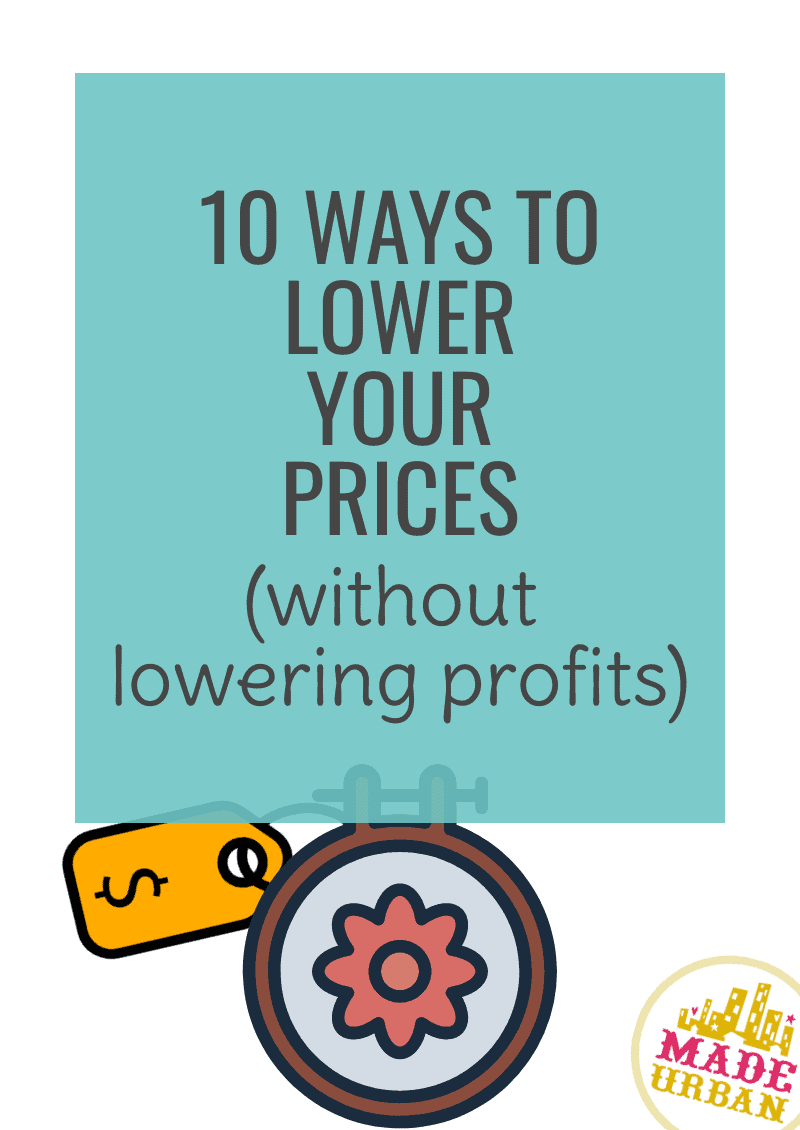10 Ways to Lower your Prices (without lowering profits)
Lowering the prices of your handmade products, just to make more sales, tends to do more harm than good (here’s why). But what should you do if you’ve properly calculated your prices (here’s how to do that), and your items are overpriced and not selling?
Below are 10 things you may try to help lower your costs so you can lower prices without sacrificing profits (or keep your prices the same but profit more).
1) Limit types of products & product options
A common problem handmade business owners run into is creating too many types of products, or offering too much variation in their products. Too much variety will increase your costs, as well as your production times.
Let’s say I make handbags, jewelry, and knitted goods. Each of those products requires different materials (which require time to research, shop for, buy, pay for shipping, etc.) and different tools.
It also requires more of my time to design each product, photograph them, write unique descriptions, source packaging/shipping materials, determine prices and shipping fees, etc.
The same is true if I’m only making one type of product but making it in a variety of ways (e.g. beaded jewelry, wire-wrapped jewelry, etc.).
Refining your product line so you sell under one category of product (e.g. bags, or jewelry, or knitted goods, but not all 3), and limiting your options will streamline your business, save you money, and make you more efficient.
>> Here’s how to tell if you’re offering too many types of products, and here are two reasons you should reduce your selection: Why Too Many Products will Harm your Craft Business’s Sales and How your Creativity is Killing Sales
If you need to reduce your product line but aren’t sure how, check out:
>> How to Develop a Product Line Using the 3 – 5 Strategy
>> How To Sell More to Each Customer (w/ a Ladder System)
2) Change your materials
If you’ve sourced the best materials but your high-quality products aren’t selling, it may be a sign that your target market doesn’t care about those high-quality materials as much as you do.
Try creating the same products and designs in materials that aren’t as expensive so you can lower your prices.
3) Change HOW you buy materials
If you reduce your product line, you won’t need so many different materials and can buy larger quantities of just a few materials, which may get you discounts. Buying materials in bulk is faster and easier for you and retailers often offer discounts because it saves them money too.
If buying in bulk isn’t an option, or you don’t get much of a discount when buying in bulk, there may still be an opportunity to save money. Instead of buying materials as you go, plan ahead and watch for sales so you can stock up on supplies when prices are low.
4) Change your sales channel(s)
Whether you sell online through Etsy or your website, at craft shows, or through retailers, consider if each sales channel is right for your business. Each channel will attract different types of shoppers and/or alter what shoppers expect.
For example, when people are shopping at a craft show, they don’t know what type of products they’ll discover, so they’re browsing and unlikely to be searching for something specific (e.g. “vegan, toxin-free facial soap”). If they stumble upon a product they like, they’re most likely prepared to spend within the $20 – $30 range. Most people won’t spend $50 and up without thinking about that purchase first (which craft shows don’t give shoppers time to do).
When a shopper is online and looking for something specific (e.g. “vegan, toxin-free facial soap”) they’re prepared to buy and likely prepared to spend more money for a harder-to-find specialty item.
If your products have a higher price point and/or are more specific (e.g. not just bars of soap but “vegan, toxin-free bars of soap”), they may be better suited for selling online.
On the other hand, if your products are a little more “basic” (e.g. bars of soap someone wouldn’t search for online or make a special shopping trip for, but rather pick up at a grocery store or farmers’ market), they may sell better at craft shows and farmers’ markets rather than online.
You also must think about the costs associated with each sales platform. Craft show costs can add up (here are 10 costs you may be ignoring) and selling wholesale means your prices must be high enough to offer a 50% discount and still profit.
Be sure you’re advertising and selling in a place that reaches your target market and is a fit for your business.
5) Limit product features
Adding fewer details to your work means you spend less time creating your products and use fewer materials. Consider your target market and the features they care about most; you don’t want to remove a detail that’s a major selling feature.
For example, adding a zippered pocket to the inside of my bags requires extra time and money. I would consider how many pockets are necessary and if I can get away with adding a pocket without a zipper (which requires less time and money).
Consider how much a product feature costs and adds to the price.
Then consider if your customers were given the choice (e.g. pay an extra $5 for a zippered interior pocket), would they want to spend that money on the feature?
If the answer is no, consider reducing (e.g. fewer pockets) or getting rid of the product detail.
6) Speed up production
As you reduce your production time, how much you must pay yourself (in wages) will also reduce, which will lower your costs. The more times you make a product, the faster you’ll get at making it (to an extent). But there are little things you can do to break the process into steps and prep in bulk.
For example, if I’m sewing a bag I might do all of my cutting first (e.g. cut enough pieces to make 10 bags, not just one). I must clear a table, pull out all my cutting tools and dig out my fabrics, so doing all this for one or two bags wastes time. Then I might sew all the straps for all 10 bags, then sew pockets, etc.
Breaking your work into steps allows you to get into a workflow and become more efficient at the task at hand. You’ll also save time by not having to switch tools or move around your craft room.
It may only seem like small time-savings, but they add up.
7) Watch your ROI
Before you spend time or money on your business, estimate your ROI (return on investment). For example, how much will it cost you to participate in a craft show and how much do you think you can make from it? If you’re not making more than you’re spending (don’t forget about your wages for your time), then consider if you should skip it.
This applies to any aspect of your business; running Facebook ads, setting up a new social media account, creating a new product, getting into a new retail store, etc.
The less you must spend on your business, the lower your overhead costs will be (which must be worked into your product’s prices).
8) Invest in time-saving tools
Sometimes, you need to spend money to make money. Are there any parts of your business that take up a lot of your time? Perhaps it’s tracking sales, filing taxes, sending newsletters, etc. You must be paid for your time so the longer it takes you to complete a business task, the higher your overhead costs, and the higher your prices will go.
If there are any time-suckers in your business, first consider if you can eliminate them (based on its ROI). And if not, see if there is a faster way to complete them.
9) Watch the little expenses
As a small handmade business owner, you likely have a lot on your plate and aren’t tracking expenses as closely as you should. But everything you spend time or money on must be accounted for if you want to build a profitable business.
When I worked for a major retailer, each store had a mission to find the smallest of savings. One task we had was to tidy our stock rooms so they ran more efficiently (the quicker a sales associate could find a size, the quicker they make a sale) and supplies were better organized. Placing an order for paper towels when a full box of them are hiding on a shelf eats into a store’s bottom line.
Pay close attention to your expenses that fall outside of production costs to see if there’s anything you’re spending money on you don’t have to.
Don’t forget about your time either.
Making 5 trips to the post office each week not only uses more gas and puts more wear and tear on your vehicle, it takes up more of your time. One might create a policy that orders are shipped on Tuesdays and Thursdays so they’re only making 2 trips per week. They may also have a rule that they say no to any craft show invitations that require them to drive longer than 30 minutes.
Reduce your overhead costs, which will allow you to lower your prices.
10) Increase perceived value
People may not be willing to pay your current prices because they don’t believe your products are worth that. What surrounds your products is just as important as the products themselves.
If you’ve created a beautiful pair of earrings but are displaying them on a flimsy piece of cardstock with the price scribbled on it, and then placed it inside a plastic bag, those earrings are not going to appear to be worth very much money.
On the other hand, if they’re displayed on a glossy piece of cardstock that’s branded and shares a tagline that helps explains the earring’s value, shoppers will be willing to spend more on them.
This applies to your online shop design, product photos and descriptions, product packaging, craft show display, etc.
Paying more attention to the details that surround your products may help shoppers see their true value, and you may not need to lower your prices after all.
Although this may increase costs initially, in the long run, it will benefit your sales.
Do you have any cost-saving techniques? Please share in the comments!


Hey, I’m Erin 🙂 I write about small business and craft show techniques I’ve learned from being a small business owner for almost 2 decades, selling at dozens of craft shows, and earning a diploma in Visual Communication Design. I hope you find my advice helpful!

I have started removing my price tags when a customer checks out. They are just going to throw it in the trash, but it saves me money and time to be able to reuse them. I’ve been really happy with adding this step.
What a great idea Cheryl! Very smart 🙂
~Erin
I’m struggling with creating a website for my woven items to link with my Instagram and Facebook pages. What are other sellers doing in this regard? Should I go down the path of hiring a pro to help me with this step?